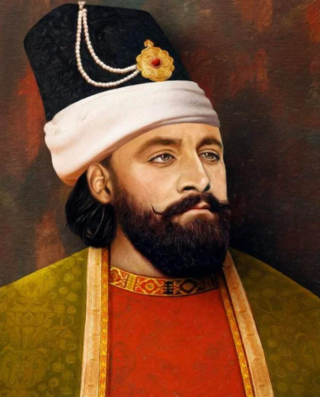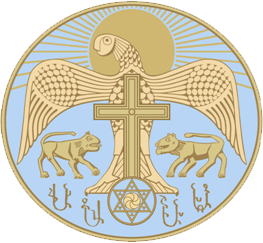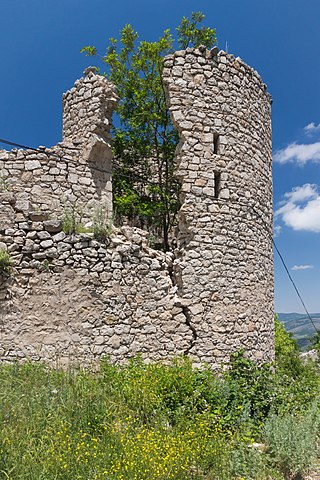Related Research Articles

Nagorno-Karabakh is a region in Azerbaijan, covering the southeastern stretch of the Lesser Caucasus mountain range. Part of the greater region of Karabakh, it spans the area between Lower Karabakh and Syunik. Its terrain mostly consists of mountains and forestland.

Shusha or Shushi is a city in Azerbaijan, in the region of Nagorno-Karabakh. Situated at an altitude of 1,400–1,800 metres (4,600–5,900 ft) in the Karabakh mountains, the city was a mountain resort in the Soviet era.

The Karabakh Khanate was a khanate under Iranian and later Russian suzerainty, which controlled the historical region of Karabakh, now divided between modern-day Armenia and Azerbaijan. In terms of structure, the Karabakh Khanate was a miniature version of Iranian kingship. The administrative and literary language in Karabakh until the end of the 19th century was Persian, with Arabic being used only for religious studies, despite the fact that most of the Muslims in the region spoke a Turkic dialect.
Nagorno-Karabakh is located in the southern part of the Lesser Caucasus range, at the eastern edge of the Armenian Highlands, encompassing the highland part of the wider geographical region known as Karabakh. Under Russian and Soviet rule, the region came to be known as Nagorno-Karabakh, meaning "Mountainous Karabakh" in Russian. The name Karabakh itself was first encountered in Georgian and Persian sources from the 13th and 14th centuries to refer to lowlands between the Kura and Aras rivers and the adjacent mountainous territory.

Davit Bek or David Beg was an Armenian military commander and the leader of an Armenian rebellion against the invading Ottoman Empire and implanted Safavid Muslim tribes in the mountainous region of Zangezur. He was one of the most prominent military figures of the Armenian liberation movement of the 18th century.

Мelik was a hereditary Armenian noble title used in Eastern Armenia from the Late Middle Ages until the nineteenth century. The meliks represented some of the last remnants of the old Armenian nobility. The most prominent and powerful meliks were those of Karabagh (Artsakh) and Syunik, which ruled autonomous or semi-autonomous principalities known as melikdoms under Iranian suzerainty. Meliks also existed in Yerevan, Nakhichevan, Sevan, Lori, Northwestern Persia, and other areas, although outside of Karabagh and Syunik most were merely hereditary leaders of local Armenian communities, not rulers of principalities.

Karabakh is a geographic region in southwestern Azerbaijan and eastern Armenia, extending from the highlands of the Lesser Caucasus down to the lowlands between the rivers Kura and Aras. It is divided into three regions: Highland Karabakh, Lowland Karabakh, and the eastern slopes of the Zangezur Mountains.
Ibrahim Khalil Khan Javanshir was the second khan of the Karabakh Khanate from the Javanshir family. He was the son and successor of Panah-Ali khan Javanshir.

Panah Ali Khan Javanshir was the founder and first ruler of the Karabakh Khanate under Persian suzerainty.

Hasan-Jalalyan is a medieval Armenian dynasty that ruled over parts of the South Caucasus. From the early thirteenth century, the family held sway in Khachen in what are now the regions of lower Karabakh, Nagorno-Karabakh, and Syunik in modern Armenia. The family was founded by Hasan-Jalal Dawla, an Armenian feudal prince from Khachen. The Hasan-Jalalyans maintained their autonomy over the course of several centuries of nominal foreign domination by the Seljuk Turks, Persians and Mongols. They, along with the other Armenian princes and meliks of Khachen, saw themselves as holding the last bastion of Armenian independence in the region.

Askeran is a town in the Khojaly District of Azerbaijan, in the region of Nagorno-Karabakh. Until 2023 it was controlled by the breakaway Republic of Artsakh, as the centre of its Askeran Province. The town had an ethnic Armenian-majority population until the exodus of the Armenian population of Nagorno-Karabakh following the 2023 Azerbaijani offensive in Nagorno-Karabakh. It is located on the left bank of the Karkar River (Qarqarçay), approximately 11 kilometres (7 mi) northeast of the regional capital, Stepanakert.

The Kingdom of Artsakh was a medieval dependent Armenian kingdom on the territory of Syunik and Artsakh provinces, Gardman canton of Utik province, Mazaz and Varazhnunik canton of Ayrarat province. Contemporary sources referred to it as the Khachen. However, because the domain of Khachen during the reign of Prince Hasan Jalal included the entire territory of the modern Nagorno Karabakh Republic plus many contiguous lands to its west, south and north, his principality was often called the Kingdom of Artsakh. The royal house of Khachen was a cadet branch of the ancient Syunid dynasty and was named Khachen, after its main stronghold. Hasan-Jalal traced his descent to the Armenian Aranshahik dynasty, a family that predated the establishment of the Parthian Arsacids in the region.

The province of Karabakh was a north-western province of the Safavid Iran, centered on the geographic region of Karabakh.

The Five Melikdoms of Karabakh, also known as Khamsa Melikdoms, were Armenian feudal entities on the territory of modern Nagorno-Karabakh and neighboring lands, from the dissolution of the Principality of Khachen in the 15th century to the abolition of ethnic feudal entities by the Russian Empire in 1822.
Mirza Jamal Javanshir was a secretary and historian under the Karabakh Khanate and later the Russian Empire. He is principally known as the author of the Persian-language historical chronicle Tarikh-e Qarabagh.
Melik Shahnazar II was the melik of Varanda, one of the five Melikdoms of Karabakh, in the 18th century. He is a controversial figure in Armenian history, whose actions contributed significantly to the demise of the Armenian Melikdoms of Artsakh.

Gara Boyuk Khanim Castle is an 18th century palace-castle located on a hill in the southeastern part of the town of Shusha (Shushi) in the Karabakh region of Azerbaijan. It is composed of four towers in a square plan. It is one of the two castles of Shusha that have survived to present day.
Sargis II Hasan-Jalalyan was the last catholicos of Aghvank from 1810 to 1815.
Avan-khan III or Yegan III was the Armenian ruler of Dizak from 1716 to 1744 and the ancestor of Melik-Aslanyan and Melik-Yeganyan families.

From 1724 to 1731, an Armenian rebellion occurred in Karabakh under the leadership of the Melikdoms of Karabakh. Initially directed against the collapsing Safavid state, it fought against the Ottoman invasion of Eastern Armenia. Chronologically, it coincided with the Syunik rebellion.
References
- ↑ Bournoutian 1994, p. 43 (see note 67).
- ↑ Hewsen 2001, p. 163.
- ↑ Bournoutian 1994, pp. 52–53 (see note 107).
- ↑ Hewsen 2001, pp. 146, 163.
- ↑ Małalyan 2007, pp. 161–163.
- ↑ Tsibenko 2018.
- ↑ Hewsen 1972, p. 326.
- 1 2 Hewsen 1972, p. 301.
- 1 2 Hewsen 2013, pp. 25–28.
- ↑ Bournoutian 1994, p. 54 (see note 109).
- ↑ Małalyan 2007, pp. 158–198.